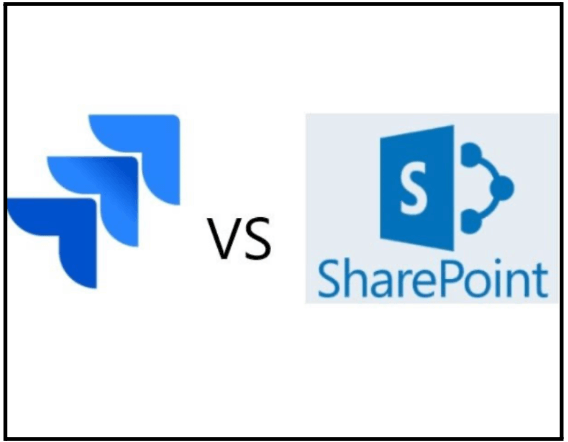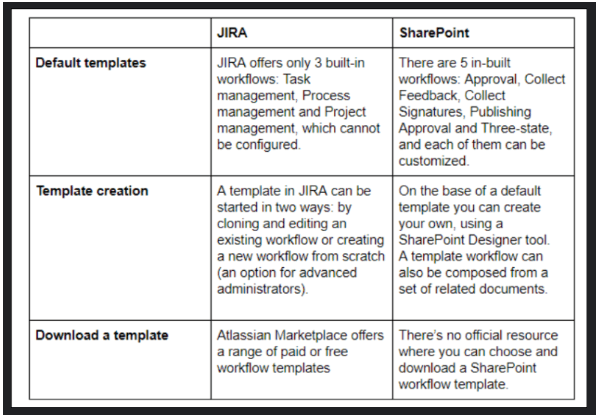Sharepoint Vs Jira

Jira is the leading issue tracking and project management system for agile software development groups. Jira’s secret sauce is the manner in which it reduces the intricacies of software development into manageable components of work Jira starts out-of-the-box with all that agile teams must provide value to consumers faster.
SharePoint facilitates teamwork and information sharing in today’s offices. Each project team, division, as well as department can have their own dynamic and effective team site. Facilitate teamwork, facilitate information discovery, and ensure smooth cross-departmental collaboration by centrally managing content, expertise, and applications.
Jira is part of the technology stack’s Issue Tracking section, while SharePoint is more typically used as file storage.
Table of Contents
What is SharePoint?
- Create intranet sites, webpages, document libraries, as well as lists on your computer, Mac, or handheld device with Microsoft SharePoint.
- To make your site more unique, use web parts.
- Share images, videos, and other media along with updates and announcements on a group website.
- Find, track, and lookup anything and anyone in your organization.
- Workflows, forms, as well as lists can help you organize your daily activities.
- Put everything on the cloud as well as sync it so that everyone may work together safely.
- Get your news fix wherever you go by downloading the mobile application.
What Is Jira?
Jira is a project management, bug tracking, as well as workflow automation tool created by the Australian software firm Atlassian.
There are four fundamental ideas in Jira: issues, projects, boards, and workflows.
-
Issue:
The process of monitoring the development of a single task, from its inception to its resolution, is known as an issue. A problem might be a bug, a user narrative, a major project, a to-do list for an HR team, or a document that the documentation team must create.
Problems have several names, including tickets and tasks. Avoiding ambiguity is easier if you stick to issues or the categories of issues you define.
Epic, Story, Bug, Test, as well as Task are the common sorts of problems handled by product teams.
-
Projects:
A project is a container for related concerns and the data and history that informs those issues. Project-related issues can have their visibility and related workflows adjusted in a number of ways. Having a dedicated Jira project for every item can be useful when using the tool to aid with product development.
-
Boards:
The board in Jira is a graphical depiction of your team’s workflow inside a project. Multiple boards provide for varied perspectives, management, and reporting on the same project’s performance.
If you’re using an agile methodology, you might find it useful to keep tabs on your backlog items with a Kanban Board, as well as display your Sprint Backlog on a Sprint Board.
-
Workflows:
You might think of a workflow as the route that problems travel as they make their way through the work from inception to conclusion.
Issues can have many different states, and the different labels in a workflow, like “To Do,” “In Progress,” and “Done,” represent these states. You can set up workflows to control how an issue goes between states and what happens after it does so.
Jira vs SharePoint
The table describes the differences in several sectors in detail:

Actions to Integrate Jira and Sharepoint
Here, we’ve listed a few straightforward actions you may do to integrate Jira and Sharepoint with Sharepoint online Training, in addition to a few other essentials.
-
Applications in Business:
Senior management in an array of organizations do not want to commit the time, energy, and cash required to independently connect to Jira since they already have access to SharePoint to track personnel or manage resources. Allowing Jira to communicate as well as share data with SharePoint is a straightforward answer to these issues and concerns.
You can use Jira’s advanced search features, which require administrator privileges, to find this information. WebHooks allow Jira to send an HTTP call upstream to an external app or website whenever a certain event occurs within Jira. Information is not simply shared within SharePoint.
Combine Jira and SharePoint:
The instructions below will walk you through connecting Jira to SharePoint.
- Configure WebHooks in Jira. Build a WebHook by providing its desired name, URL, scope, as well as events. Without clearly defining these four elements, it is importance to create a reliable connection.
- Set up the SharePoint Team Site. With Sharepoint online Training, you can set up shared or isolated workspaces for your team to collaborate on documents, share updates, and even notify external parties of significant changes. Integrate Jira Connector into the group site and set up the link.
Steps 1 and 2 finish the development of the link between Jira as well as SharePoint. Create defined events in Jira that you wish to send to your linked SharePoint, and then test the connection as well as the smooth flow of work.
Knowing how to use the features and options in Jira with Sharepoint online Training makes your work much simpler. In this article, we’ve outlined a few simple procedures that should make it possible for you to integrate Jira with any service, including SharePoint. This improves your knowledge of Jira and your ability to use it.
Conclusion
Among the StackShare community, Jira is more well-liked than SharePoint, with 2128 company stacks as well as 1530 developer stacks mentioning it, respectively.
Professionals and amateurs alike can struggle with Jira projects as well as software if they don’t grasp the proper techniques and approaches.
If you continue to have doubts or you are encountering problems with any parts of the process then Sharepoint online Training may assist you out. You will have an extremely in-depth idea of the aforementioned procedures, which can assist to dispel any lingering confusion and give you a clear picture of how everything fits together.
Author Bio:

Pradeep is tech-savvy, currently working as a content contributor at mindmajix.com. He writes articles on various tech spaces -Business Intelligence, Testing, Cloud, Project Management, Document Management etc.

